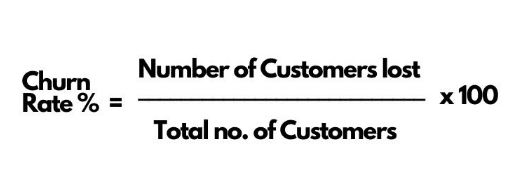Want to ensure your business reaches the ultimate heights of success and conversion? It’s time to practice tracking, thoroughly inspecting, and then skillfully utilizing all the proper sales growth metrics and KPIs. Only then you can boost your sales and business revenues significantly, making a big mark in whichever industry your business is a part of.

But when new to the world of online business or eCommerce stores, most business owners wonder if their sales strategies or marketing campaigns are working fruitfully. In many cases, many of them are not even sure how to find out if they are. And not just them, some of the most seasoned business strategists and CEOs might find themselves scratching their heads trying to figure out how to boost conversions.
Thankfully, the sales growth metrics exist, and they can provide you with all the necessary answers you need to know about the growth of the sales of your products and services. And today, we are here with a complete list of all the most important sales growth metrics and KPIs that can skyrocket your business’ success in no time. Therefore, without further ado, let’s get started.
Understanding What Is Meant By Sales Growth & All Related Metrics
Before we can get into our ultimate list, it’s best we start off by explaining what sales growth is for all those who are new to the topic or need a quick refresher. So, Sales Growth (or, sometimes also called Sales Growth metric) is a metric that’s used to calculate and evaluate your team’s ability to increase revenue over a fixed period. In simpler words, it is a measurement of your company’s sales performance.

For any company to grow successfully over time, it needs to accumulate the right amount of revenue constantly. If that isn’t possible, your company runs the risk of being surpassed by competitors and losing customers. As a result, when attempting to evaluate performance and make important decisions about how to organize your campaigns and grow your business’s profitability, the sales growth measure is a crucial strategic indicator to consider. These metrics will tell you exactly which areas of your progress plan need modifications and improvements.
How To Calculate Sales Growth Metrics?
There is a simple formula that can be used to calculate sales growth metrics is quite simple:
Sales Growth Metrics = [(Sales for the current period – Sales for the previous period) / Sales for the previous period] x 100
Are Sales Growth Metrics & KPIs Synonymous With Each Other?
Everything we have discussed till now is about sales growth metrics, but a very common question that is very frequently asked is ‘whether sales growth metrics and KPIs are the same things?’ And the answer to that is – no, they are not. While sales growth metrics and key performance indicators (KPIs) are closely related to each other, they are not synonymous and not the same.

We have already defined that Sales Growth metrics are used to define the performance of the sales structure and sales executive team of a company. Online business owners can make better-informed decisions about conversions and revenue, marketing, customer satisfaction, and operations by tracking the correct sales KPIs.
On the other hand, a sales KPI is one of the sales metrics used to measure performance against strategic goals. Metrics track the business process or its progress, while KPIs measure the performance of the process. KPIs are metrics that show how successful you are at accomplishing specified objectives or targets in your business processes. However, there are also KPIs subjective to individual businesses because not all online stores are in the same state, nor have the same goals for success. For example, if a business seeks to boost sales by 15%, sales growth is the KPI, and sales revenue is the metric.
How You Can Make The Best Use Of Sales Growth Metrics & KPIs?
To understand better why you should track sales growth metrics and KPIs for your business, here are some of the primary reasons why you should track the sales metric:

🎯 Improves Employee Performance By Providing Insights
Many employees have difficulty determining whether or not they are progressing or making a positive impact on the organization they are working for. Sales metrics provide employees with a simple scorecard that provides them with overall information about how well they are developing in the proper strategic route.
🎯 Helps Identify Issues & Loopholes In Sales Strategies
To make improvements in the company and ensure sales growth, you must be aware of what’s going wrong in your strategic plans and campaigns. And sales growth metrics are the perfect solution to look at here, they help you identify the problems in the company and allow you to work on new ideas for change that can result in better outcomes.
🎯 Get A Better Focus On The Progress Of Your Business
Sales metrics can help you change that and put your focus where it needs the most. As mentioned earlier, you will be able to find and focus on all the loopholes in your sales strategies and other areas that need attention. And eventually, you can easily take proper measures to prevent any losses in your business
These are just a few of the compelling reasons why tracking sales analytics is critical for your company. Now that you’ve grasped the significance of sales metrics, let’s look at the 15 sales metrics that you must unquestionably monitor.
The 10+ Most Important Sales Metrics For Successful Business Growth
Every company’s nature of business differs from the other, and so do their sales metrics. If one sales metric is critical to a certain company, it might not be the same for the other. And, it is often very easy to get lost among the hundreds of business sales growth metrics and analytics. There is not a single sales metric critical for all companies, be it within the same industry.
To help you understand the concept of key sales growth metrics and make long-term positive impacts on your online business, we have made a list of the topmost important eCommerce metrics. You can effortlessly skyrocket your sales by keeping track of and optimizing these analytics.
But before we can get into the list, you need to understand what eCommerce metrics are and why they are so valuable in growing your business. Interested to learn more? Then keep reading!
1) Sales Conversion Rates
Your Sales Conversion Rate is the most important sales metrics to track, regardless of how renowned or new your company is. It’s a percentage that determines how many visitors to your website complete their purchases and become paying customers. Any business must determine how much traffic converts and generates revenue.
To calculate your company’s sales conversion rate, you need to find the percentage of users purchasing your products. To learn how to calculate these critical metrics, simply look at the formula below:

Other than this calculation method, the best practice to track the sales conversion rate is to use Google Analytics and set up a goal. To understand how to set up your Google Analytics goal and how to use it to determine the performance of your company’s sales strategies, we recommend you give ‘Analyze Enhanced eCommerce Data’ a read.

2) Total Revenue & Annual Recurring Revenue
Closely following, we have another important sales growth metric for any business of any industry is Total Revenue. It can be measured based on different time intervals – yearly, quarter-yearly, monthly, or weekly.
The total amount of contracted revenue your company brings in each year is known as annual recurring revenue or ARR. It’s a highly important key performance indicator (KPI) to track for any subscription-based company. This is because it indicates how much money you can expect to receive from clients over the course of a fiscal year. ARR can be used to analyze a company’s growth and aid in long-term forecasts when tracked historically.
3) Average Revenue Per Account/Product/Customer
The average revenue per user (ARPU) or average revenue per account (ARPA) refers to the amount of money that a company brings in per subscriber, user, or account in a particular time period. It is calculated by dividing the total amount of revenue for that time period by the number of subscribers, customers or accounts during that period:
If your ARPU is rising, it means your revenue is retaining its worth. Identifying your highest ARPU clients can also help you figure out where your product fits best in the market. Leaders and managers can use the average income generated by a single product, service, account, or customer to determine where they should spend their attention and resources.
4) Market Penetration & Its Percentage
Understanding your market share is an important sales growth metric since it indicates where your company stands in relation to the projected growth in your business or sales plan. Typically, businesses would compare this to their total addressable market (TAM), which is an estimate of the size of a specific market for a product or service.
5) The Sales Win Rate
Next up, we have the metrics known as ‘Win Rate‘, also known as the Opportunity-To-Win, refers to the percentage of deals that are closed won within a specific time period. By “Closed Won” we mean the stage at which a potential user has signed a contract and is now considered a customer. It’s one of the perfect ways to analyze and determine sales effectiveness in the market.

7) Average Profit Margin
Average profit margin measures, in essence, is the KPI that ultimately tells you how well your company is doing in the market. It is calculated by dividing your company’s net income by its net sales. And it can also be measured by product, region, and rep to gain insight into how each segment of the business is performing.
8) Pipeline Coverage
The sales growth metric, Pipeline Coverage, refers to the number of prospects in your sales pipeline that will allow you to meet your sales goal and targets. Many businesses use the three-to-one rule, but how you calculate it depends on a variety of criteria, including your business segment, product, sales cycle duration, and more.
9) CRM Score
CRM Score is an artificial intelligence-driven score based on historical data from opportunities, such as how long a deal has been in a certain sales stage, if the sales close date has been moved in or pushed out, and whether the deal size has increased or decreased.
10) Sales Linearity
Then we have, Sales Linearity, which is the consistent and predictable pattern of deals closing over the course of a quarter. This sales growth rate and KPI helps avoid the last-minute rush to close business and meet quotas at the end of the quarter.
11) Average Deal Size
This indicator reflects your sales team’s ability to move up the market and close bigger agreements. Is your message resonating with clients who have more disposable income? Are your salespeople capable of navigating complex sales cycles with higher price tags?
To determine where the most profitable transactions are, average deal size should be tracked by the total business for the given time period (monthly, quarterly, yearly), as well as broken down by renewals and new deals. The average deal size or average selling price refers to the average dollar amount of each closed deal.
12) Churn Rate
Churn rate refers to the number of your customers who either cancel or don’t renew their subscriptions during a specific time period. Customer churn is an important measure to track for any subscription-based business.

Your net growth remains zero if you’re losing clients at the same rate as you’re getting them. This is why it’s critical to safeguard your customer base, give excellent customer service, and continue to develop in order to create value.
Identifying accounts in danger of churning can be difficult and typically necessitates the use of sophisticated spreadsheets, but modern sales tools give revenue teams additional visibility into at-risk renewals, allowing them to adopt a proactive approach to avoiding churn.
How Often Should You Measure & Analyze Your Sales Growth Metrics?
Sales growth metrics need to be measured and analyzed regularly for the best outcome:

🗓️ Weekly: Some metrics should be monitored on a weekly basis to verify that your company is in good shape. Website traffic and social media engagement are all examples.
🗓️ Bi-weekly: These measures are ideally suited for metrics with larger sample sizes, as they are less influenced by week-to-week changes. Average order value (AOV), cost per acquisition (CPA), and shopping cart abandonment is examples of bi-weekly eCommerce metrics.
🗓️ Monthly: Some eCommerce metrics such as the ones related to email marketing can be measured monthly as they depend on website traffic numbers and your own marketing strategies.
🗓️ Quarterly: Other eCommerce metrics can be viewed quarterly or yearly. These are the most strategic and are usually used to measure the overall condition and growth of your business.
Effortlessly Measure Your Sales Growth Metrics To Grow Your Business
There are several sales growth metrics and KPIs you can track to understand your customers and the business progress, but the ones mentioned above are key. Any store aiming to reach success should focus on them. If you analyze these top metrics and take proper measurements to enhance them, your business is sure to perform at its best.
We hope you find our list helpful in growing your online business. If you try out any of the methods listed above, do let us know about your experience by commenting below; we would love to hear from you! To learn more valuable information about your online businesses like this, subscribe to our blog. You can also join our friendly Facebook community to know about our latest updates.






